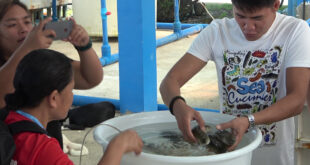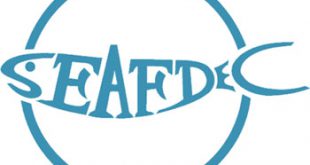| In abalone culture, omnivores rule |
| Diets with both plant and animal sources strike the perfect balance between nutritive content and cost |
| A prized aquaculture commodity, the tropical abalone Haliotis asinina has a high market demand in both local and export markets. Because of this, researchers are trying to come up with diet formulations that could support greater growth while minimizing feed cost.
Abalones are herbivores in their natural habitats, feeding mostly on macroalgae like seaweeds. In the culture environment, however, experiments from Taiwan have noted that abalone juveniles fed formulated diets had 65% greater growth than those fed solely with macroalgae. In addition, they were found to contain relatively higher protein content than the seaweed-fed abalone.
Formulated feed must contain sufficient nutrients like protein and amino acids to encourage growth of H. asinina. Palatability, digestibility and the presence of the right balance of amino acids are important considerations in choosing the protein source to be incorporated in the artificial diet.
The study conducted by Myrna Bautista-Teruel and colleagues of SEAFDEC/AQD focused on the development of practical diets for the abalone, with emphasis on the determination of suitable protein sources such as fish meal, defatted soybean meal and the blue-green alga Spirulina sp. for incorporation in the formulated diets.
In their tests, the proponents prepared four practical diets. Diet 1 consisted of either fishmeal (FM), shrimp meal (SM) and defatted soybean meal (DSM) as the main protein sources. Diet 2 was composed of FM and DSM, Diet 3 was made up of DSM and SP, and Diet 4 consisted of FM, SM, and SP at 27%. These were then fed to abalone juveniles under controlled environments.
Eighty-four days later, results showed Diet 2-fed abalone to have the highest weight gain of 453.8%. However, the results were not significantly higher than those fed with Diet 4. Diet 3 registered lower weight gain, growth rates and length gains in abalone. The results showed that a feed protein from a combination of plant and animal sources promoted better growth rates than those prepared from plant origins alone. One of the reasons cited for this is that Diet 3 had low levels of the essential amino acid methionine, which are found in larger amounts from animal sources.
Since the reliance on animal-based feed diets alone could prove expensive, combining them with plant-based protein sources could strike the perfect balance between sustained growth rates and minimal cost.
Read more of this article from the journal Aquaculture (2003) 219: 645-653. |
Check Also
Vacancy: Associate Researchers (FHS)
Vacancies: 2 ASSOCIATE RESEARCHERS (entry position; could be a RESEARCHER depending on the qualifications) Assignment: …
 SEAFDEC/AQD Southeast Asian Fisheries Development Center | Aquaculture Department
SEAFDEC/AQD Southeast Asian Fisheries Development Center | Aquaculture Department


